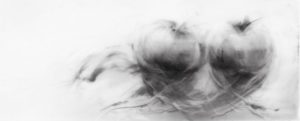Greta Gundersen died in July of cancer. She was a private person, and I hadn’t known she was sick until a few weeks before her death. I had had the sense that something was wrong, for I had written a short essay for an exhibition she was due to have this fall and had heard nothing back when I sent it to her, which wasn’t like her at all.
I met Greta fifteen years ago. A museum curator had recommended her as an artist whose work might be appropriate for an exhibition I was organizing for a New York gallery. The show was to be a multigenerational one, with 150-year-old paintings by members of the Hudson River School hung next to works by contemporary artists. I contacted Greta and asked if she could send me some images. “My works don’t reproduce well,” she told me. “Why don’t I just bring some of the smaller ones to you?” So it was that a week later I met Greta and saw her paintings.
“These are great!” I enthused. “I want them for the show!”
“Are you sure?” Greta asked doubtfully. “You don’t want some time to think it over?”
Her response was, I came to learn, quintessentially Greta. Although a native New Yorker, through her Norwegian heritage she always carried a bit of Lake Wobegon.
Landscape was the common element of the show I had planned, and I wanted to see what the paintings from different eras had to say to each other. Greta’s paintings pushed the genre about as far as it could go. They could be read as landscapes, but they could also be regarded as abstract paintings.

Greta discussed her links to landscape painting quite cogently, “While grounded in the natural world, the process of translating an image into paint becomes a matter of abstracting and distilling the details, until the painting hovers between abstraction and representation, embodying the place where the liminal becomes visible.”
“Liminal” is related to limits, to occupying a position at, or on both sides of, a boundary or threshold. It is simplistic to reduce a shimmering painting with dark tones below and light tones above to a depiction of a landscape at twilight or as seen through fog, but we inevitably do it. “Color doesn’t need form because it is the form,” Greta asserted, but the viewer’s mind wants a more everyday meaning, and it struggles to make visual sense of these floating veils of color in terms of something it already knows. Greta worked without impasto on very smooth surfaces, so there are no physical cues caused by minute shadows of the brush’s traces or the texture of the support poking through from beneath the paint to give us the sense that we are viewing a physical surface. Instead, the image simply floats before us, simultaneously a two-dimensional plane and a window into some luminous space.
J.M.W. Turner’s and Mark Rothko’s works obviously come to mind, and Gundersen acknowledged them as influences. On the other hand, she came to her obsession with ambiguous surfaces in a way that few artists would: she had a condition called “monocular vision.” In most humans, our brains take the visual data being relayed by each eye and synthesize it, giving us a three-dimensional image. For people like Greta, the brain doesn’t combine the two images, leaving a two-dimensional world in front of her. I assume it’s like going through the world after losing one eye, though perhaps there are overlapping two-dimensional worlds.
As a young woman, Greta worked with ophthalmological machines and did exercises, attempting to gain “normal” vision, but she found the hints of stereoscopic sight she achieved quite disorienting and stopped any further attempts. She was already an artist by that time, and she found that the way she had grown up seeing the world had its artistic rewards. “To ‘compensate,’ I see colors that most people miss,” she wrote. In a ‘flat’ world, things are very clear. The sky moves from up and down.”
When it came to drawing, likewise, Greta worked in a different manner than most artists. She would cover yupo paper, an extremely smooth synthetic paper, with powdered graphite, leaving a dark surface. She would then create her image by erasing the graphite, almost a way of drawing with light.

Garlic bulbs, onions, dead bats, dried roses – all of her subjects hover lightly on the page, little miracles of perception.
In my last e-mail to Greta, after I had learned how serious her condition was, I wrote her, “I hope that you make it, but I’m not going to be all smiley smiles. Will you try to keep one thing in mind when you’re at your lowest? Some people leave children behind them, but you will leave paintings. And they’re good paintings, works that will be able to make their way in the world when you’re not here.”
And so they will.

